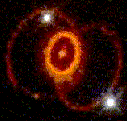 |
||
| First page | ||
 |
||
| Birth | ||
 |
||
| Main Sequence | ||
 |
||
| White Dwarf | ||
 |
||
| Red giant | ||
 |
||
| Supernova | ||
 |
Death | |
 |
||
 |
||

A star can have a mass as large as 100 times the mass of the Sun. What is the destiny for these really massive stars?
The initial stages of evolution are similiar for all stars, but in stars with masses greater than about 10 solar masses the core can reach a temperature high enough to lead to the fusion of even heavier nuclei. When the temperature in the core finally becomes hot enough to fuse silicon to form iron, then energy generation must cease.

After this a massive star builds a white dwarf in its centre, where no nuclear reactions are taking place. No energy is being generated in the white dwarf core of the star, but fusion does still occur in shells surrounding the core. After a while it gets so massive that the force exerted by degenerate electrons is no longer great enough to resist gravity. The electrons merge with the protons to produce neutrons and when these electrons disappear it removes the main source of support for the core which collapses until its density exceeds that of an atomic nucleus.

The core rebounds and it transfers energy outwards, blowing off the outer layers of the star in a violent supernova explosion. A supernova is more luminous and stays bright for longer than a nova. There are two different types of supernovae; type I occur in binary systems in which a white dwarf accretes enough matter to push its mass over a certain limit and type II supernovae are the explosions of massive stars.
Some supernovae leave behind a rotating neutron star, called a pulsar (pulsating radio sources). Astronomers have reported that it's probable that some pulsars are accompanied by planets. These planets would certainly not be suitable for life since the pulsar emits most of its energy as an intense stellar wind.
23 August 2000
Sarah Amandusson
www_astro@mssl.ucl.ac.uk